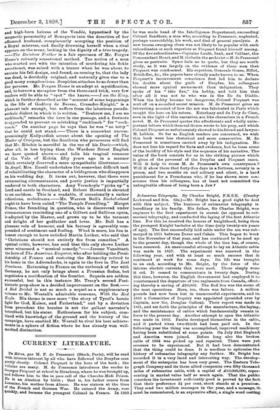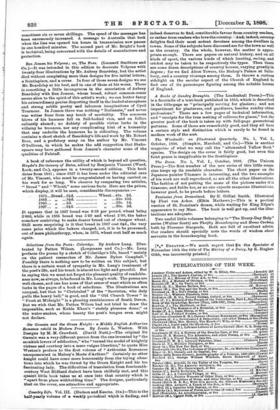Submarine Telegraphs. By Charles Bright, F.R.S.E. (Crosby - Lockwood and Son.
63s.)—Mr. Bright has a good right to deal with this subject. The business of submarine telegraphy is hereditary in his family. His father, Sir Charles Bright, was engineer to the first experiment in oceanic (as opposed to anti- marine) telegraphy, and conducted the laying of the first Atlantic line. For this he received the honour of knighthood, being then the youngest Knight bachelor at the time (only twenty-six years of age). The first successfully laid cable under the sea was sub- merged in 1851 between Dover and Calais. This began to 'work in the November of that year, and has continued to be used np to the present day, though the whole of the line has, of course, been renewed. An unsuccessful attempt to lay an Atlantic cable was made in 1857. The experiment was renewed in the following year. and with at least so much success that it. continued at work for some days. Its life was brought. to an end, according to Mr. Bright, by the force of the intense electric currents that were used. These simply wore it out. It ceased to communicate in twenty days. During' this time, however, the English Government had employed it to. countermand the departure of two regiments from Canada, effect- ing thereby a saving of £50,000. The Red Sea was the scene of the next operations- Here, too, there was failure. A million pounds had now been lost in unsuccessful experiments, and in. 1859 a Committee of Inquiry was appointed (presided over by Captain, now Sir, Douglas Gallon). Their report was made in. 1861, and set forth the principles of the manufacture, the laying,. and the maintenance of cables which fundamentally remain in force to the present day. Another attempt to span the Atlantic was made in 1865. Faults developed themselves in the cable,. and it parted when two-thirds had been paid out. In the following year the thing was accomplished, improved machinesy having been substituted at some points. On July 21st England and America were joined. Before long also the broken cable. of 1866 was picked up and repaired. There were yeti. reverses to be experienced. But it had been demonstrated. that the thing could be done. It is needless to epitomise the history of submarine telegraphy any further. Mr. Bright bas recorded it in a very lucid and interesting way. The develop- ment of the enterprise has been very great. The Eastern Tele- graph Company and its three allied companies own fifty thousand. miles of submarine cable, with a capital of £10,000,000, repre- senting in market value half as much again. That the public considers the investment sufficiently good is proved by the fact that their preference 3} per cent. stock stands at a premium. They send two million messages in the year, and a message, it: must be remembered, is an expensive affair, a single word costing
sometimes six or seven shillings. The speed of the messages has been enormously increased. A message to Australia that took when the line was opened ten hours in transmission now passes in one hundred minutes. The second part of Mr. Bright's book is technical, being concerned with the details of manufacture and protection.























































 Previous page
Previous page